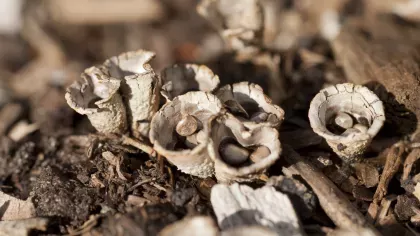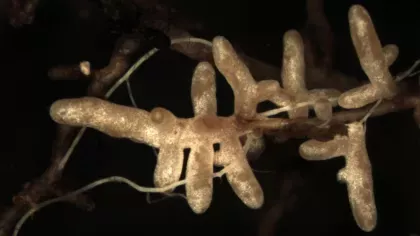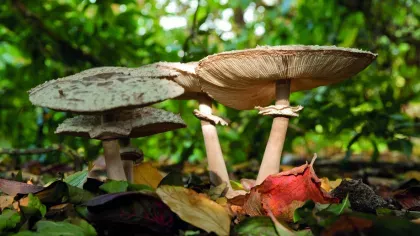Boyacá’s Forgotten Kingdom
This project is designed to explore the diversity of the Kingdom Fungi in Boyacá, Colombia.

Background
Colombia is known to be one of the most biodiverse countries in the world. Nevertheless, the current knowledge on inventory and monitoring of biodiversity and ecosystems does not fully reflect this richness, being incomplete in certain regions. Counteracting this situation, the nation-wide ‘Colombia Bio’ programme has recently been established by the Colombian government with the main aim of making sustainable economic use of Colombia’s biodiversity resources. This programme offers a unique opportunity for Kew and partner organisations in Colombia to undertake primary research on biodiversity and ecosystem services in parts of the country as yet completely unexplored. The goal of this exploratory research is to enable the establishment of a long-term agenda on the conservation and sustainable use of Colombia’s natural capital.
Kew Science will be involved in a significant number of research projects over the next 4-5 years (from 2017) under the umbrella of the Colombia Bio programme.
The goal of the project described here is to assess the unknown fungal diversity in the department (region) of Boyacá in Colombia, and will run for 10 months until March 2018.
The forgotten Kingdom…
Found in virtually every ecological niche, fungi are key organisms to the environment and our lives. From nutrient recyclers, decomposers and beneficial symbiotic partners with plants and animals to food and medicine providers, they can also represent a devastating threat to ecosystems, our food resources and even to our health. Nevertheless, we still suffer from inadequate sampling and study of the kingdom Fungi in many parts of the world. Whereas 135,000 species of fungi have been described worldwide so far (Hibbett et al. 2016), the most widely accepted estimation of the total number of species remains at 3 million (Hawksworth 2012). With most fungal species yet to be discovered, the extent of the importance of fungi is most likely underestimated. This is the case for Colombia, and specifically in the region of Boyacá, a virgin land for fungal exploration. Moreover, with major environmental threats such as climate change, we may be losing fungal species to extinction before we even discover them in understudied areas like Boyacá. Fungal research in Colombia could unveil similar diversity patterns as a recent study in southern South America (Truong et al. 2017). Just a 50-day fungal inventory revealed up to 308 potentially new species not previously included in the global sequence repositories.
Our Aims in Boyacá
For the first time, this project aims to close the gap and assess the unknown fungal diversity in the department of Boyacá, Colombia, by using a field-to-lab approach, merging expeditions, standard barcoding techniques, genomic approaches, and newly developed methods to sequence in the field, with traditional specimen-based identification methods, building on the long-standing expertise in mycology at Kew as well as the expertise in genetic methods at the Alexander von Humboldt Biological Resources Research Institute in Colombia. Moreover, at a time when fungal biologists and mycology training are decreasing in most academic institutions, we seek to provide training of local researchers in new techniques as well as in general fungal diversity and taxonomy.
By using the latest molecular techniques, we hope to uncover fascinating insights into Boyaca’s fungi. Knowing how many species are there and how they relate to each other will help us understand the roles those species may play in the different ecosystems, as well as any potential applications; for example, is a critical trait found in one species (e.g., antibiotic production) likely also to be found in its relatives? Do unrelated species occurring in similar ecological niches produce equivalent chemical products? How is it that fungi strikingly different in physical appearance can share a common ancestor, or that similar appearance can result from quite separate evolutionary pathways.
Objectives
The overall goal of this project is to answer the question of what fungal species can be found in Boyacá, implementing state-of-the-art approaches to analyse fungal diversity and developing a new protocol that is reproducible and easy to disseminate. To this aim, our study is divided into three objectives:
- Collect and document fungal specimens and soil samples in the four types of habitats present in Boyacá. The altitude ranges from approximately 100m to over 3,000m above the sea level, creating very different ecosystems throughout the region such as wet tropical forest, dry forest, high altitude forest and páramos – i.e., high, tropical, montane vegetation above the forest line. During these trips, we will focus our collections on macrofungi producing fruiting bodies, lichens and soil samples.
- Estimate the fungal biodiversity in the area, combining DNA data and taxonomic expertise. We will implement DNA barcoding and (meta)genomic approaches complemented with phylogenetic inference for a more accurate taxonomic annotation and better information about the fungal biodiversity in the area. Specimens that fall within the key genera identified for the PAFTOL project will be further analysed using whole-genome next-generation sequencing (Illumina HiSeq). As with field collections, we will further compare the genetic and species diversity among the different habitats where collections are made, as this assessment could help us make predictions of diversity for future collections in other areas.
- Train the next generation of fungal diversity researchers in Boyacá, Colombia, and strengthen local capabilities. We will do this by including local researchers in each step of the project: from collecting samples to fungarium preparation, from DNA extractions to DNA barcoding, and from genome sequencing to bioinformatics. In addition, a workshop will be organized and delivered by Kew mycologists to train professionals on fungal taxonomy and diversity. After project delivery, we will assess the feasibility of establishing a PhD programme on fungal diversity in partnership with RBG Kew.
- The creation of a duplicated reference collection of fungi specimens; one to be stored in a local fungarium in Boyacá (Colombia) and one in the fungarium at RBG Kew.
- A first estimate of species richness in the area, evaluation of potential species uses, and sampling to capture biodiversity that could be extrapolated to other departments.
- The reconstruction of a phylogenetic framework to improve the taxonomic placement of collected specimens and to understand the roles that species may play in the different ecosystems, as well as any potential applications.
- The creation of a database of digital images, collection locations, and field identifications, which will subsequently be added to Colombia’s Biodiversity Information System (SIB Colombia), the data portal Boyacá BIO, and linked to the Naturalista website.
- Integration of data generated in this project in the PAFTOL strategic output, as key genera will be selected for whole-genome sequencing to directly feed into the Fungal Tree of Life currently targeted in PAFTOL.
- The dissemination of research to the public and researchers through publications, workshops and basic field guides.
- The development of a training programme in mycology, in partnership with the Colombian research team, through fieldwork training, the organisation of a workshop on fungal diversity and taxonomy, and the outlining of a PhD programme.
See our scientists at work in Colombia, 2017:
- Mailyn González. Humboldt Institute, Colombia
-
Universidad Pedagógica Tecnológica de Colombia (UPTC), Colombia
-
Bibiana Moncada. Universidad Distrital Francisco José de Caldas, Colombia
-
Diego Fernando Simijaca Salcedo. Universidad Distrital Francisco José de Caldas, Colombia
-
Robert Lücking. Botanical Garden and Botanical Museum, Berlin, Germany
-
Aida Vasco Palacios, Tecnológica de Antioquia, Medellin, Colombia
- Royal Botanic Gardens, Kew
- UK Department for Business, Energy & Industrial Strategy (BEIS)
- UK Official Development Assistance (ODA)
- Newton Fund
- The British Council
- Colombian National Royalties’ System
- Administrative Department of Science, Technology and Innovation of Colombia (Colciencias)
Hawksworth, DL (2012)
Global species numbers of fungi: are tropical studies and molecular approaches contributing to a more robust estimate?
Biodivers Conserv 21:2425–2433. DOI 10.1007/s10531-012-0335-x
Herrera Vargas, L. J., Sipman, H. J., & Gutiérrez Sarmiento, M. C. (2014)
A Remarkable Cladoniaceae Flora at SubAndean Region in Chámeza (Casanare, Colombia)
Caldasia, 36(2), 231-238
Hibbett, D, Abarenkov, K, Kõljalg, U, Öpik, M, Chai, B, Cole, J, Wang, Q, Crous, P, Robert, V, Helgason, T, Herr, JR, Kirk, P, Lueschow, S, O'Donnell, K, Nilsson, RH, Oono, R, Schoch, C, Smyth, C, Walker, DM, Porras-Alfaro, A, Taylor, JW, Geiser, DM (2016)
Sequence-based classification and identification of Fungi
Mycologia 108: 1049-1068. DOI: 10.3852/16-130
Moncada, B., & Lücking, R. (2012)
Ten new species of Sticta and counting: Colombia as a hot spot for unrecognized diversification in a conspicuous macrolichen genus
Phytotaxa, 74(1), 1-29
Moncada, B., Lücking, R., & Suárez, A. (2014)
Molecular phylogeny of the genus Sticta(lichenized Ascomycota: Lobariaceae) in Colombia
Fungal Diversity, 64(1), 205-231
Mateus, N., & Lücking, R. (2011)
CONTRIBUCIONES A LA BIOTA LIQUÉNICA FOLIÍCOLA DE COLOMBIA. I. NUEVOS REGISTROS DEL GÉNERO COENOGONIUM (ASCOMYCOTAOSTROPALES: COENOGONIACEAE)
Revista de la Academia Colombiana de Ciencias Exactas, Físicas y Naturales, 35(137), 425-430
Mateus, N., Aguirre, J., & Luecking, R. (2012)
Contributions to the foliicolous lichen biota of Chocó (Colombia)
Caldasia, 34(1), 25-32
Rincón-Espitia, A., Aguirre-C, J., & Lücking, R. (2011)
LÍQUENES CORTICÍCOLAS EN EL CARIBE COLOMBIANO/Corticolous lichens in the Caribbean region of Colombia
Caldasia, 331-347
Sipman, H.J.M.; Hekking, W. y Aguirre, J. (2008)
Checklist lichenized and lichenicolous fungi of Colombia
Biblioteca José Jerónimo Triana, 20, 1-242
Sipman, H.J.M. & Aguirre-Cebayos, J. (2016)
Liquenes. In Bernal, R. Gradstein, S.R. & Celis, M (eds)
Catalogo de las plantas y liquenes de Colombia. Vol. 1: 159-281.
Truong, C, Mujic, AB, Healy, R, Kuhar, F, Furci, G, Torres, D, Niskanen, T, Sandoval-Leiva, PA, Fernández, N, Escobar, JM, Moretto, A, Palfner, G, Pfister, D, Nouhra, E, Swenie, R, Sánchez-García, M, Matheny, PB, and Smith, ME (2017)
How to know the fungi: combining field inventories and DNA-barcoding to document fungal diversity
New Phytol 214: 913-919. DOI: 10.1111/nph.14509
Vasco-Palacios, AM, and Franco-Molano, AE (2013)
Diversity of Colombian macrofungi (Ascomycota – Basidiomycota)
Mycotaxon 121:4


